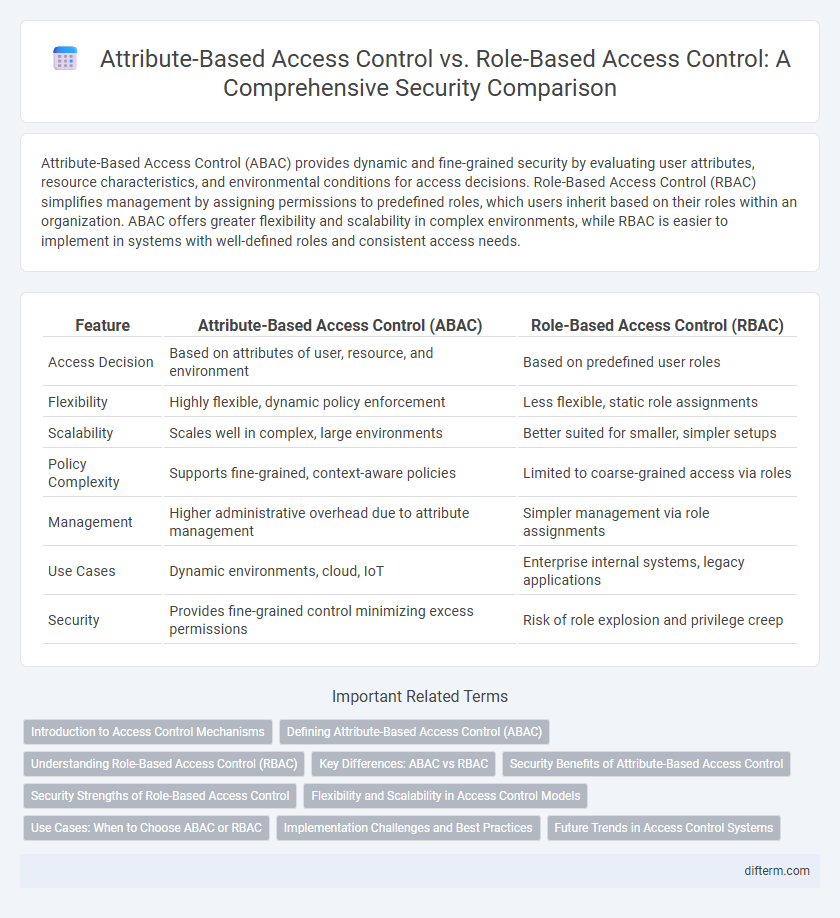Attribute-Based Access Control (ABAC) provides dynamic and fine-grained security by evaluating user attributes, resource characteristics, and environmental conditions for access decisions. Role-Based Access Control (RBAC) simplifies management by assigning permissions to predefined roles, which users inherit based on their roles within an organization. ABAC offers greater flexibility and scalability in complex environments, while RBAC is easier to implement in systems with well-defined roles and consistent access needs.
Table of Comparison
| Feature | Attribute-Based Access Control (ABAC) | Role-Based Access Control (RBAC) |
|---|---|---|
| Access Decision | Based on attributes of user, resource, and environment | Based on predefined user roles |
| Flexibility | Highly flexible, dynamic policy enforcement | Less flexible, static role assignments |
| Scalability | Scales well in complex, large environments | Better suited for smaller, simpler setups |
| Policy Complexity | Supports fine-grained, context-aware policies | Limited to coarse-grained access via roles |
| Management | Higher administrative overhead due to attribute management | Simpler management via role assignments |
| Use Cases | Dynamic environments, cloud, IoT | Enterprise internal systems, legacy applications |
| Security | Provides fine-grained control minimizing excess permissions | Risk of role explosion and privilege creep |
Introduction to Access Control Mechanisms
Access control mechanisms regulate user permissions to ensure data security by verifying identity and defining access rights. Attribute-Based Access Control (ABAC) utilizes dynamic conditions such as user attributes, resource types, and environmental factors for fine-grained access decisions. Role-Based Access Control (RBAC) assigns permissions based on predefined roles, simplifying management but offering less flexibility compared to ABAC's context-aware policies.
Defining Attribute-Based Access Control (ABAC)
Attribute-Based Access Control (ABAC) defines access permissions based on attributes such as user characteristics, resource types, and environmental conditions, enabling fine-grained and dynamic security policies. Unlike Role-Based Access Control (RBAC), ABAC evaluates multiple attributes in real-time, allowing context-aware decisions that enhance flexibility and precision in access management. This model supports complex organizational requirements by leveraging attribute-based rules to enforce least privilege and compliance in sensitive environments.
Understanding Role-Based Access Control (RBAC)
Role-Based Access Control (RBAC) assigns permissions to users based on their roles within an organization, streamlining access management by grouping users with similar responsibilities and access needs. This model enhances security by enforcing the principle of least privilege, ensuring users only access resources necessary for their job functions. RBAC supports scalability and compliance in complex environments by simplifying policy administration and reducing the risk of unauthorized access.
Key Differences: ABAC vs RBAC
Attribute-Based Access Control (ABAC) enforces access decisions based on user attributes, resource attributes, and environmental conditions, offering fine-grained and dynamic access control. Role-Based Access Control (RBAC) assigns permissions to predefined roles, simplifying management but lacking flexibility in complex or context-sensitive environments. ABAC enhances security through contextual policies, while RBAC provides ease of administration and scalability for straightforward access scenarios.
Security Benefits of Attribute-Based Access Control
Attribute-Based Access Control (ABAC) enhances security by enabling fine-grained access decisions based on user attributes, environmental conditions, and resource characteristics, reducing the risk of unauthorized access. Unlike Role-Based Access Control (RBAC), ABAC supports dynamic policy enforcement that adapts to context changes, improving overall system resilience. ABAC's flexibility in defining complex and context-aware access rules strengthens compliance with regulatory requirements and minimizes attack surfaces in cybersecurity frameworks.
Security Strengths of Role-Based Access Control
Role-Based Access Control (RBAC) enhances security by minimizing access privileges through predefined roles, reducing the risk of unauthorized access. Its hierarchical structure allows for efficient enforcement of least privilege principles, ensuring users only access necessary resources. RBAC's centralized management simplifies audit trails and compliance, strengthening overall security posture in enterprise environments.
Flexibility and Scalability in Access Control Models
Attribute-Based Access Control (ABAC) offers greater flexibility than Role-Based Access Control (RBAC) by evaluating user attributes, resource types, and environmental conditions for dynamic, fine-grained access decisions. RBAC, while simpler to implement, struggles with scalability when managing numerous roles in large organizations, leading to role explosion and administrative overhead. ABAC's policy-driven structure enables scalable management of complex access control scenarios across diverse systems without the need to create an expansive number of roles.
Use Cases: When to Choose ABAC or RBAC
Attribute-Based Access Control (ABAC) excels in environments requiring fine-grained access decisions based on dynamic contextual attributes such as user location, device type, and time of access, ideal for complex, high-security scenarios like cloud services and healthcare systems. Role-Based Access Control (RBAC) is most effective for organizations with stable roles and permissions, providing straightforward management and enforcing policies in structured settings like enterprise resource planning (ERP) systems and internal company networks. Choosing ABAC over RBAC is crucial when access must adapt to varying conditions and user attributes, whereas RBAC simplifies administration when role hierarchy and responsibilities are well-defined and relatively static.
Implementation Challenges and Best Practices
Implementing Attribute-Based Access Control (ABAC) requires handling complex policies and dynamic attributes, posing scalability challenges compared to Role-Based Access Control (RBAC) which centers on predefined roles and simpler management. Best practices for ABAC include investing in robust attribute management systems and continuous policy refinement, while RBAC implementation benefits from clear role definitions and periodic role audits. Both models require comprehensive logging and monitoring to ensure secure and compliant access control environments.
Future Trends in Access Control Systems
Future trends in access control systems emphasize the growing adoption of Attribute-Based Access Control (ABAC) due to its granular context-aware policies and dynamic user attributes. Unlike traditional Role-Based Access Control (RBAC), ABAC enables real-time decision-making by evaluating multiple attributes such as user location, device security posture, and time of access. The integration of artificial intelligence and machine learning further enhances ABAC's capability to adapt to evolving security threats and complex enterprise environments.
Attribute-Based Access Control vs Role-Based Access Control Infographic

 difterm.com
difterm.com